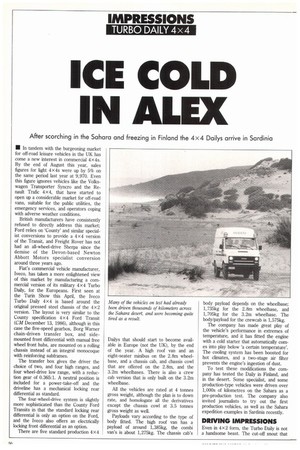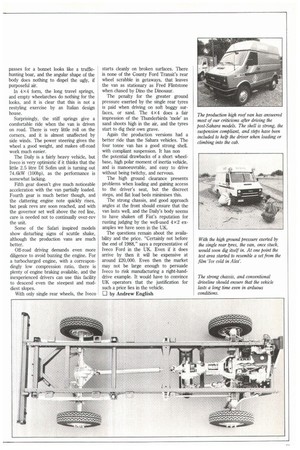ICE COLD IN ALEX
Page 52

Page 53

If you've noticed an error in this article please click here to report it so we can fix it.
After scorching in the Sahara and freezing in Finland the 4x4 Dailys arrive in Sardinia
• In tandem with the burgeoning market for off-road leisure vehicles in the UK has come a new interest in commercial 4 x4s. By the end of August this year, sales figures for light 4x 4s were up by 5% on the same period last year at 9,970. Even this figure ignores vehicles like the Volkswagen Transporter Syncro and the Renault Trafic 4x 4, that have started to open up a considerable market for off-road vans, suitable for the public utilities, the emergency services, and operators coping with adverse weather conditions.
British manufacturers have consistently refused to directly address this market; Ford relies on 'County' and similar specialist conversions to provide a 4 x4 version of the Transit, and Freight Rover has not had an all-wheel-drive Sherpa since the demise of the Devon-based Newton Abbott Motors specialist conversion around three years ago.
Fiat's commercial vehicle manufacturer, Iveco, has taken a more enlightened view of this market by manufacturing a commercial version of its military 4 x4 Turbo Daily, for the Europeans. First seen at the Turin Show this April, the Iveco Turbo Daily 4x4 is based around the original pressed steel chassis of the 4x2 version. The layout is very similar to the County specification 4 x4 Ford Transit (CM December 13, 1986), although in this case the five-speed gearbox, Borg Warner chain-driven transfer box, and sidemounted front differential with manual free wheel front hubs, are mounted on a rolling chassis instead of an integral monocoque with reinforcing subframes.
The transfer box gives the driver the choice of two, and four high ranges, and four wheel-drive low range, with a reduction gear of 0.365:1. A neutral position is included for a power-take-off and the driveline has a mechanical locking rear differential as standard.
The four-wheel-drive system is slightly more sophisticated than the County Ford Transits in that the standard locking rear differential is only an option on the Ford, and the Iveco also offers an electrically locking front differential as an option.
There are five standard production 4x4 Dailys that should start to become available in Europe (not the UK), by the end of the year. A high roof van and an eight-seater minibus on the 2.8m wheelbase, and a chassis cab, and chassis cowl that are offered on the 2.8m, and the 3.2m wheelbases. There is also a crew cab version that is only built on the 3.2m wheelbase.
All the vehicles are rated at 4 tonnes gross weight, although the plan is to down rate, and homologate all the derivatives except the chassis cowl at 3.5 tonnes gross weight as well.
Payloads vary according to the type of body fitted. The high roof van has a payload of around 1,385kg, the combi van's is about 1,275kg. The chassis cab's body payload depends on the wheelbase; 1,735kg for the 2.8m wheelbase, and 1,705kg for the 3.2m wheelbase. The body/payload for the crewcab is 1,575kg.
The company has made great play of the vehicle's performance in extremes of temperature, and it has fitted the engine with a cold starter that automatically comes into play below 'a certain temperature'. The cooling system has been boosted for hot climates, and a two-stage air filter prevents the engine's ingestion of dust.
To test these modifications the company has tested the Daily in Finland, and in the desert. Some specialist, and some production-type vehicles were driven over 1,000s of kilometres on the Sahara as a pre-production test. The company also invited journalists to try out the first production vehicles, as well as the Sahara expedition examples in Sardinia recently.
DRIVING IMPRESSIONS
Even in 4x 2 form, the Turbo Daily is not a handsome beast. The cut-off snout that passes for a bonnet looks like a trufflehunting boar, and the angular shape of the body does nothing to dispel the ugly, if purposeful air.
In 4x4 form, the long travel springs, and empty wheelarches do nothing for the looks, and it is clear that this is not a restyling exercise by an Italian design house.
Surprisingly, the stiff springs give a comfortable ride when the van is driven on road. There is very little roll on the corners, and it is almost unaffected by side winds. The power steering gives the wheel a good weight, and makes off-road work much easier.
The Daily is a fairly heavy vehicle, but Iveco is very optimistic if it thinks that the little 2.5 litre DI Sofun unit is turning out 74.6kW (100hp), as the performance is somewhat lacking.
Fifth gear doesn't give much noticeable acceleration with the van partially loaded. Fourth gear is much better though, and the clattering engine note quickly rises, but peak revs are soon reached, and with the governor set well above the red line, care is needed not to continually over-rev the unit.
Some of the Safari inspired models show disturbing signs of scuttle shake, although the production vans are much better.
Off-road driving demands even more diligence to avoid buzzing the engine. For a turbocharged engine, with a correspondingly low compression ratio, there is plenty of engine braking available, and the inexperienced drivers can use this facility to descend even the steepest and muddiest slopes.
With only single rear wheels, the Iveco starts cleanly on broken surfaces. There is none of the County Ford Transit's rear wheel scrabble in getaways, that leaves the van as stationary as Fred Flintstone when chased by Dino the Dinosaur.
The penalty for the greater ground pressure exerted by the single rear tyres is paid when driving on soft boggy surfaces, or sand. The 4x4 does a fair impression of the Thunderbirds 'mole' as sand shoots high in the air, and the tyres start to dig their own grave.
Again the production versions had a better ride than the Sahara vehicles. The four tonne van has a good strong shell. with compliant suspension. It has non the potential drawbacks of a short wheelbase, high polar moment of inertia vehicle, and is manoeuvrable, and easy to drive without being twitchy, and nervous.
The high ground clearance presents problems when loading and gaining access to the driver's seat, but the discreet steps, and flat load beds minimises this.
The strong chassis, and good approach angles at the front should ensure that the van lasts well, and the Daily's body seems to have shaken off Fiat's reputation for rusting judging by the well-used 4x2 examples we have seen in the UK.
The questions remain about the availability and the price. "Certainly not before the end of 1988," says a representative of Iveco Ford in the UK. Even if it does arrive by then it will be expensive at around 220,000. Even then the market may not be large enough to persuade Iveco to risk manufacturing a right-handdrive example. It would have to convince UK operators that the justification for such a price lies in the vehicle.
by Andrew English




































































































